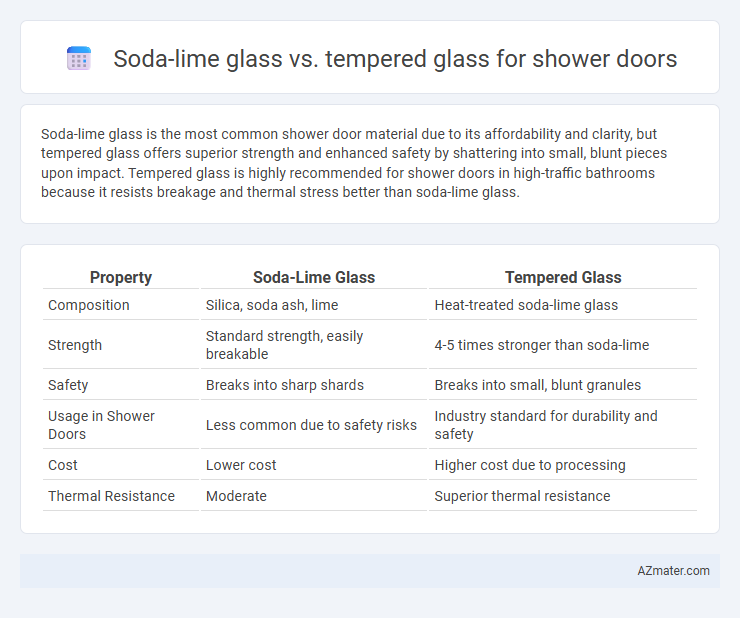Soda-lime glass is the most common shower door material due to its affordability and clarity, but tempered glass offers superior strength and enhanced safety by shattering into small, blunt pieces upon impact. Tempered glass is highly recommended for shower doors in high-traffic bathrooms because it resists breakage and thermal stress better than soda-lime glass.
Table of Comparison
| Property | Soda-Lime Glass | Tempered Glass |
|---|---|---|
| Composition | Silica, soda ash, lime | Heat-treated soda-lime glass |
| Strength | Standard strength, easily breakable | 4-5 times stronger than soda-lime |
| Safety | Breaks into sharp shards | Breaks into small, blunt granules |
| Usage in Shower Doors | Less common due to safety risks | Industry standard for durability and safety |
| Cost | Lower cost | Higher cost due to processing |
| Thermal Resistance | Moderate | Superior thermal resistance |
Introduction to Shower Door Glass Types
Soda-lime glass, the most common type of glass used in shower doors, offers affordability and ease of customization but lacks enhanced safety features. Tempered glass, produced through a heat treatment process, provides superior strength and shatters into small, blunt pieces, significantly reducing injury risks. Choosing between soda-lime and tempered glass depends on safety requirements, durability, and budget considerations for shower door installations.
What is Soda-Lime Glass?
Soda-lime glass, the most common type of glass used in shower doors, is composed primarily of silica (silicon dioxide), soda (sodium oxide), and lime (calcium oxide), offering affordability and versatility. This glass type provides good clarity and is easily shaped but lacks the strength and safety features of tempered glass. Understanding soda-lime glass's chemical composition and physical properties is essential when comparing it to tempered glass for shower door applications.
What is Tempered Glass?
Tempered glass is a type of safety glass processed by controlled thermal or chemical treatments to increase its strength compared to soda-lime glass, which is the standard glass used in most household windows. The tempering process enhances the glass's resistance to impact and thermal stress, making it an ideal choice for shower doors where durability and safety are paramount. Unlike soda-lime glass, tempered glass shatters into small, blunt pieces when broken, reducing the risk of injury.
Strength and Durability Comparison
Tempered glass offers superior strength compared to soda-lime glass, as it is heat-treated to withstand impacts and thermal stress, making it less prone to breakage in shower doors. Soda-lime glass, commonly used in standard glass applications, lacks the reinforced structure and can shatter more easily under pressure or sudden temperature changes. The enhanced durability of tempered glass ensures greater safety and longevity in high-moisture environments like bathrooms.
Safety Features: Soda-Lime vs Tempered
Tempered glass for shower doors offers superior safety features due to its enhanced strength and shattering pattern, breaking into small, blunt pieces that reduce injury risk compared to soda-lime glass. Soda-lime glass is more prone to breakage into sharp, dangerous shards, posing a higher safety hazard in wet environments. Building codes and industry standards often mandate tempered glass for shower enclosures to ensure maximum user protection and durability.
Cost Differences: Budget Considerations
Soda-lime glass is generally more affordable than tempered glass, making it a popular choice for budget-conscious shower door installations. Tempered glass involves additional heat treatment for enhanced strength and safety, which increases production costs and results in higher retail prices. For homeowners prioritizing durability and safety while managing expenses, understanding this cost difference is essential for making an informed decision.
Installation and Maintenance Needs
Soda-lime glass shower doors require careful installation with precision to prevent cracks, often needing professional handling due to their fragile nature. Tempered glass offers easier installation because its strength allows for more forgiving handling and adjustments, reducing risk of damage during setup. Maintenance for soda-lime glass involves frequent cleaning to avoid surface scratches, while tempered glass requires less upkeep as it resists breakage and withstands everyday wear.
Aesthetic Qualities and Design Options
Soda-lime glass offers a clear, smooth surface that enhances light transmission and provides a sleek, minimalist look ideal for modern shower doors. Tempered glass, while equally clear and smooth, comes with added safety features and can be customized with patterns, frosted finishes, or tinted options, allowing for versatile aesthetic design choices. Both types support frameless and framed installations, but tempered glass enables more complex shapes and sizes due to its increased strength.
Environmental Impact and Recycling
Soda-lime glass, commonly used in shower doors, has a lower environmental impact due to its abundant raw materials and ease of recycling in standard glass waste streams. Tempered glass undergoes heat treatment that increases strength but complicates recycling because it shatters into small pieces, making separation from other materials challenging. Choosing soda-lime glass supports more efficient recycling processes and reduces energy consumption compared to tempered glass, contributing to a more sustainable bathroom solution.
Choosing the Right Glass for Your Shower Door
Soda-lime glass is the most common material for shower doors, offering affordability and good clarity, but it lacks the strength and safety features compared to tempered glass. Tempered glass undergoes a heat-treatment process that increases its durability and causes it to break into small, less harmful pieces, making it ideal for high-impact areas like shower enclosures. Choosing tempered glass ensures enhanced safety, resistance to thermal stress, and longer-lasting performance for your shower door.

Infographic: Soda-lime glass vs Tempered glass for Shower door
 azmater.com
azmater.com